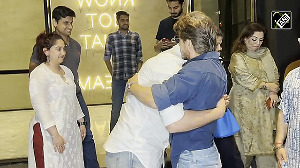When we travel abroad it is interesting to compare the issues that engage the people and leaders of various countries at that point of time.
In the US the biggest preoccupation of George Bush and the American people at present is the threat of terrorism. It is very dramatically brought home as one travels in the country. Airport security is tighter than ever.
Everyone including old ladies and little children have to take off their shoes for being x-rayed. Coats have to be put through the scanner. People have accepted this additional hassle. In the UK they are preoccupied with the death of Dr Kelly, the resultant dispute between BBC and the government, and the credibility of Tony Blair.
When one returns to India the biggest preoccupation of the prime minister and the ruling party seems to be Ayodhya. It has graduated from an emotive electoral issue to the status of a priority cause.
The pledge made by the prime minister at the cremation of Paramhansa highlighted this. In a country which has 300 million people living below the poverty line and whose economy is crawling at under 5 per cent annual growth, despite its definite potential to grow at about 7 per cent to 8 per cent, it is a bizarre choice of priorities!
We wasted the first 40 years after our independence under the leadership of Nehru and his disciples chasing the shadows of socialism, self-reliance and the public sector. Our political platform was the so-called non-aligned movement with a dubious collection of anti-West forces.
It was only in the last decade of the 20th century that we seemed to have woken up to the fact that while we were chasing economic and political mirages the world had moved on, even in our backyard of South-East Asia.
Are we going to waste another three or four decades of the 21st century chasing the call of Ayodhya? If we do so, the verdict of the next generation will be harsh. To the billion people of India does it matter whether a temple or a mosque is built in Ayodhya or anywhere else? We have enough temples, mosques and churches.
For most Indians outside the Hindi belt Ayodhya has remained a part of the holy scriptures. What really matters to most people is whether jobs are being created for the 10-million young people who are entering the work force every year; whether the education and healthcare are available; whether corruption, which has its roots in our electoral process is minimised.
Ultimately our progress will depend on the rate of growth of the economy. If Indian economy could grow at its potential of 7 to 8 per cent per annum we could double our Gross Domestic Product in a decade i.e. by 2013, which is not very far! One wishes that the prime minister could dream and talk about this, not about another temple!
The route to achieve 7 to 8 per cent growth is not very difficult as has been very clearly spelt out in the book on 'Evolution of Economic Policy in India' by Prof P N Dhar. As he has pointed out capital output ratio in our economy has been already brought down from 5:1 to 4:1 as a result of delicensing of industries.
The current level of domestic savings can be increased from the current level of 23 per cent to the 1995/96 levels of 26 per cent. With FDI equal to 2 per cent of GDP the total savings/investment ratio to GDP can increase to 30 per cent. With a capital output ratio of 4, the growth rate can be 7.5 per cent, as explained in the book.
Prof Dhar has the advantage of being a scholar who served as the head of the PM's Secretariat and one of the closest advisers to the Prime Minister Indira Gandhi during the tumultuous1970's. His prescriptions combine the soundness of academic scholarship and the pragmatism of politics.
I would commend his book to the prime minister and his Cabinet colleagues. What Prof. Dhar says about the minority governments that followed the defeat of Rajiv Gandhi in Nov 1987 could apply equally well to the present government viz.
"Considerations of the long-term health of the economy and formulation of well considered responses to external challenges had no place in their agenda. The resulting incoherence of India's foreign policy was made even worse by the futile postures meant for the consumption of domestic lobbies".
If we look at the world at large, the emerging world economic order is dominated by three Regional blocks viz. North America, European Economic Community and the Asia-Pacific Ring. They maintain a relationship, which Prof Dhar has described as "competitive interdependence".
They determine the dynamics of the world economic system and influence the global political process. Most of the Latin American countries, Asean block and even the CIS countries have built up positive relationships with the 3 Regional blocks. China is being wooed by them.
Yet India is not even on the fringes of any of the blocks. We are isolated.
One of the most effective ways for India to be taken more seriously by the three Regional blocks is for us to forge an Economic Union based on free market access with willing neighbours in South Asia.
In the short term Pakistan is unlikely to join such a South Asian Union because of recent political history although this could change over a period of time.
After all, if France and Germany who have fought two World Wars could take the initiative to form the EEC, one day it could happen even between India and Pakistan. But in the meantime without waiting for Pakistan, we could take the initiative by announcing unilateral tariff preferences for imports from Sri Lanka, Nepal and Bangladesh.
All these smaller countries are naturally wary of India as a big neighbour. So we may have to provide them this comfort. The loss of revenue to us will be negligible.
In addition we could consider tax exemption for investments from these countries, which will stimulate flow of FDI. We have given such incentives in the case of investments from Mauritius, UAE, and Cyprus.
Why not for our neighbouring countries? It is more than likely that over a period of time these countries will reciprocate and we will have access to a large market.
One day we may even be able to have a common currency and Pakistan may also join in. If we can eventually create a South Asian block of almost 1500 million people we will be taken more seriously by the rest of the world. The resultant reduction in tensions between us and Pakistan could enable us to reduce defence expenditure.
It could set off a real virtuous cycle in the whole region. Can the PM and the Government focus on such a vision rather than rake up antediluvian issues like Ayodhya, which only distracts attention from real issues of development and at the same time belittles us in the eyes of the world.





 © 2025
© 2025